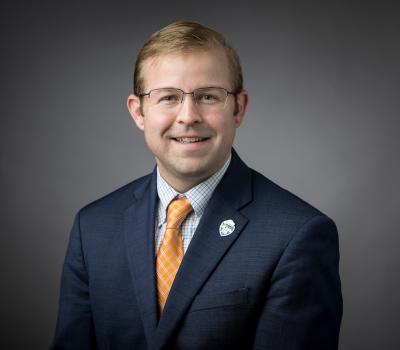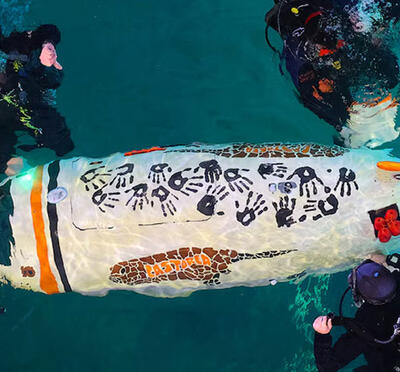On Nov. 14, 2017, the Transient Reactor Test Facility (TREAT) at the 890-square-mile Idaho National Laboratory site jumped to life for the first time in 23 years. In the run-up to that moment, technicians and engineers in the Cold War-era control room, a half-mile from the reactor itself, nudged the core until the fission reaction became self-sustaining.
Dan Wachs and a couple dozen colleagues watched the progress through a bank of windows in an adjacent room. He and a few others passed around a little spotting scope so they could see the gauges and record the readings on a whiteboard.
“We watched the power levels go up and come back down and tried to predict when the reactor would go critical,” Wachs said. “You could feel the suspense. We knew when we were getting close.”
When the reactor went critical, a cheer went up throughout the building. “We’d worked toward this moment for almost four years,” said Wachs, the national technical lead for fuel safety research at INL. Wachs earned his bachelor’s degree in mechanical engineering and master’s degrees in both nuclear engineering and mechanical engineering at Oregon State University. A doctorate in mechanical engineering from the University of Idaho followed. In February, he was inducted into the Oregon State University Academy of Distinguished Engineers.
TREAT is no ordinary reactor. It’s a valuable tool for testing the performance and limits of nuclear fuel. By generating intensely powerful neutron bursts, TREAT can safely reproduce the extreme heat and radiation that occur during hypothetical reactor malfunctions and failures, which may occur from events like coolant loss and power surges. The peak energy output (20 gigawatts) from TREAT’s core can, for brief periods, exceed by 500% the power levels produced in a large commercial reactor core.
There are just four transient test reactors in the world. Before TREAT came back online, none of them were in the United States. The U.S. Department of Energy considered that a strategic and commercial disadvantage. According to INL, the revitalized TREAT puts the country back into a position of leadership in the development of advanced nuclear fuels and reactor technology.
The DOE recommended TREAT’s revival after the 2011 Fukushima Daiichi disaster as part of a greater plan to help the U.S. nuclear industry create “accident-tolerant” fuels (ATFs). The most important quality of an ATF is its enhanced resilience at extreme temperatures. Had the Fukushima reactors run on ATF, the catastrophic hydrogen explosion and ensuing nuclear disaster might never have happened.
“Fukushima was a clear reminder that we should maintain safety testing capabilities for advanced reactors,” Wachs said.
In a transient nuclear test, a capsule containing a sample of nuclear fuel pellets is positioned inside TREAT’s core. The structure of the capsule — often called a loop — reflects the workings of part of a commercial reactor core in miniature, including its coolant flow and pressurization. Once the sample is in place, TREAT hits it with pulses of intense neutron radiation that don’t occur during normal reactor operations — a transient.
After it’s removed and examined, the test loop is put back into TREAT for another round of radiation. With each iteration, the intensity of the pulses goes up, and so does the temperature of the test sample. TREAT is capable of heating materials to 3,000 degrees Celsius — hotter than molten lava. Irradiation is repeated until the sample is damaged. The endpoint is, essentially, failure. Data gathered throughout the process provides critical information for designing accident-tolerant fuels. A complete transient test and follow-up evaluation can take weeks.
Wachs likens the process to crash testing for automobiles. “They want to know what the limits are when a car is subjected to the worst possible conditions,” he said. “We’re doing the same with nuclear fuels. We want to know under what conditions the fuel fails and use the information to create a new generation of even safer fuels.”
TREAT represents a turning point for nuclear power research. It also represents a new chapter in the working relationship between INL and the Oregon State College of Engineering’s School of Nuclear Science and Engineering (NSE). Oregon State’s nuclear program is one of a select few in the country that INL entrusts with the most sensitive and difficult research — much of it related to TREAT.
“We’ve asked Oregon State researchers to do some very difficult engineering for us,” Wachs said. “Typically they can complete experiments more quickly and less expensively than we can. Their culture is one of a common mission, and I can’t overstate how important that is to us.”
In recent years, the university has collaborated with INL on 18 research projects involving at least seven faculty researchers. Since 2016, newly contracted INL funding to Oregon State has exceeded $12.8 million. Two faculty NSE hold joint appointments at INL, and an INL engineer with a joint appointment at Oregon State teaches a highly specialized class about nuclear fuels.
One of the joint appointees is Wade Marcum, the Henry W. and Janice J. Schuette Professor in Nuclear Science and Engineering and associate head of NSE .
“Not all of our work with INL involves TREAT, but it has unquestionably been one of the most important factors in strengthening the working relationship between the school and INL,” said Marcum, who earned his bachelor’s, master’s, and doctorate in nuclear engineering at Oregon State.
Marcum serves as the primary contact between Oregon State and INL, which puts him in a position to identify projects that will be most beneficial to both organizations and to match the most appropriate researchers to a given project. In some cases, that’s himself.
For example, Marcum and his team develop and build prototypes of the loop assemblies that will be placed inside TREAT. To ensure that those prototypes are ready for transient testing, Marcum uses a powerful electric heater to heat them to the blistering temperatures they’ll encounter in the TREAT core. All that’s missing is radioactive material.
“We’re doing preliminary testing in a low-risk environment to answer a lot of the questions about how the systems perform before the actual testing in TREAT, and we’ll adjust the design as needed so that there are no unwanted surprises,” Marcum said. “A TREAT test is very expensive, and it needs to be done right the first time. We don’t want to put a loop containing a customer’s fuel rod into the reactor without covering every contingency. We can’t say, ‘Oops, we should have thought about this or that measurement beforehand. Just go to the end of the line and we’ll do better next time.’”
Graduate students often play important roles in the research; many wind up working at the lab. Marcum alone recalls about 15 of his students who went on to INL as interns, fellows, postdocs or full-time employees.
Among them is Tommy Holschuh, who spent two summers as an INL graduate intern and was later appointed as the lab’s first Deslonde deBoisblanc Distinguished Postdoctoral Associate. His primary work at INL addresses measurements of the reactor pulse, with subsequent analysis of neutron kinetics to develop methods to alter the neutron lifetime in the reactor. The research is an extension of his dissertation topic. He’s also measuring the number of fissions that occur in the TREAT irradiation samples, and he’s conducted some work for Homeland Security.
“I appreciate the flexibility that my position offers. I can continue my own research as well as get involved with new areas of investigation that interest me,” said Holschuh, who hopes to stay on full time at INL after his postdoc ends in July.
It’s a natural progression for students to return to work at the lab after internships or fellowships, Wachs said. “Every year, at least one or two students from OSU’s nuclear program end up at INL full time. They’ve already spent time here; they know the people, the facilities, the work, and they have the skills we need.” The lab is going to need a lot more people like Holschuh.
According to Wachs, half of the lab’s staff of about 4,000 will be eligible to retire in the next 10 years, and many of them are engineers. “There’s an acute lack of experimental expertise in our field,” he said. “We really need to attract a lot of people to the lab — from the Ph.D. level to technicians — and OSU is poised to be a strong source for well-trained engineers.” He added that INL intends to strengthen its connections with other areas in the College of Engineering, including mechanical, chemical, and electrical engineering.
Less than a year after the restart, a small sample of fuel was readied for transient testing. It marked the first functional application of TREAT since it began operating again and the start of the first phase of the accident-tolerant fuels program, according to Wachs. Additional tests were to follow over the next several weeks.
“When TREAT went critical, that was really when the pace of work for my group kicked into high gear,” Wachs said. “We spent months getting it ready for the first transient tests. Until that first experiment, we couldn’t really claim that the TREAT restart had been a complete success. Now we can.”




